The first proposal for a railway on the west side of Southampton Water dates from 1860 but it was to take more than 60 years before Fawley finally saw a rail service. In the nineteenth century, there were elaborate plans for a railway line to Stone Point (to the south of Fawley) to connect with a Solent tunnel to link the mainland with the Isle of Wight. However in the early years of the twentieth century it seemed that a railway-operated bus service might negate the need for a railway.

At the beginning of World War 1, the Fawley district was still essentially rural in character and apart from farming and fishing there were few industries. The construction of the oil refinery in 1920/21 by Anglo Gulf West Indies Petroleum Corporation Limited (AGWI) was, however, to change the area forever.
During the building of the refinery, potential means of transporting products from the refinery were considered. Initially a pipeline to a storage depot at Lyndhurst Road or Beaulieu Road stations was proposed but this was dropped in favour of a rail connection between the refinery and the London & South Western Railway (L&SWR) at Totton.

Early in 1921, The Totton, Hythe and Fawley Light Railway Company (TH&F) was inaugurated. Its aim was ‘To construct, maintain and work a railway, 9 miles and one furlong in length from Totton to the refinery’. The directors of the new company were Sir Joseph Davies, Chairman of AGWI, Captain Maldwin Drummond, owner of the Cadland Estate through which the new line would run for much of its length, Major Roger Cyril Hans Sloane-Stanley (another influential local land owner) and Sir Henry Crichton, a director of the L&SWR.
An application was put before the Light Railway Commissioners in March 1921. In a public enquiry at Hythe on 11 May 1921, 150 local residents stated that they would oppose the railway if stations were not provided to satisfy their needs. The enquiry was told that stations were to be provided at Marchwood, Hythe and at Fawley with the possibility of a halt at Hounsdown. There was some concern about the number of ungated level crossings but it was stated that these would all be provided with cattle grids.
Although there were some other objections the enquiry ended with the Chairman stating that the application for the Light Railway Order would be recommended to the Ministry of Transport for approval; the Light Railway Order was granted on 26 January 1922.
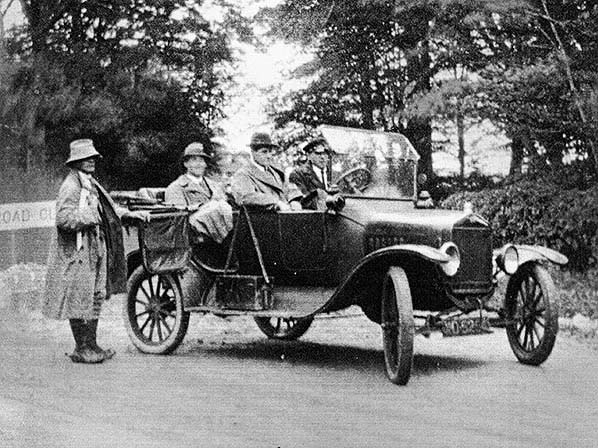 This photograph from 1924 is believed to show the engineer in charge of construction of the Fawley branch. He is probably the gentleman in the front seat with the chauffeur. The location is unclear but the background suggests near Hythe station. Note the 'Road Closed' sign partly visible in the left background. The car was apparently known as 'Queen Bess' and is a Ford Model T Tourer, registration number XO 5256 although the final digit is uncertain due to being partly obscured by the starting handle. Nevertheless enough of the number is readable under scrutiny for investigations to reveal Queen Bess was new in August 1923. The Model T is among the greatest cars ever produced and many are still in existence today. Driving one is nothing like driving a modern car and it has been said that driving a Model T is "Easy if you have never driven a car before" and anybody familiar with the Model T will see the logic in that statement.
This photograph from 1924 is believed to show the engineer in charge of construction of the Fawley branch. He is probably the gentleman in the front seat with the chauffeur. The location is unclear but the background suggests near Hythe station. Note the 'Road Closed' sign partly visible in the left background. The car was apparently known as 'Queen Bess' and is a Ford Model T Tourer, registration number XO 5256 although the final digit is uncertain due to being partly obscured by the starting handle. Nevertheless enough of the number is readable under scrutiny for investigations to reveal Queen Bess was new in August 1923. The Model T is among the greatest cars ever produced and many are still in existence today. Driving one is nothing like driving a modern car and it has been said that driving a Model T is "Easy if you have never driven a car before" and anybody familiar with the Model T will see the logic in that statement.
Photo from Waterside Heritage
The Totton, Hythe and Fawley Light Railway Company was on good terms with the L&SWR who wholeheartedly supported the new line by agreeing to manage, maintain and work the line on the condition that it was offered a lease and a seat on the TH&F board.
At a meeting between the board and the L&SWR on 3 July 1922 it was agreed that the L&SWR should take over the powers granted to the TH&F by the 1921 Light Railway Order. On 1 March 1923 the Ministry of Transport granted the Totton, Hythe and Fawley Light Railway (Amendment and Transfer) Order, 1923, whereby the rights, powers, privileges, duties and obligations of the TH&F became vested in the L&SWR. The provisions of the 1921 Railway Act took effect from the start of 1923 with the L&SWR becoming part of the Southern Railway.
The Southern Railway quickly proceeded with the construction and its solicitor and Chief Engineer, Alfred Weeks Szlumper, were instructed to acquire land and prepare plans for the railway. In March 1923, the centre line of the route was pegged out and the purchase of land followed rapidly with most landowners supporting the project. By July, all the necessary plans and drawings had been prepared. Eight contractors were invited to submit tenders with the contract being awarded to Sir Robert McAlpine and Co Ltd on 4 October.
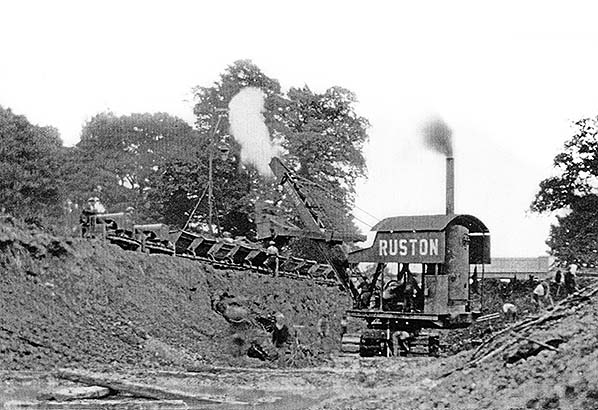 Construction work underway between Marchwood and Hythe, probably sometime in 1924. In the background is Jones Lane, Hythe, overbridge. This is bridge E18/13 and today has separate steel pedestrian bridges, one on the north side and one on the south side, as there is no footpath provision on the bridge itself. What we are seeing here is the cutting being excavated and spoil being loaded into narrow gauge side-tipping hopper wagons for removal from the site. The narrow gauge tracks would have been moved as work progressed. The train has a pair of Simplex locomotives, probably petrol engined, at its head. The photograph is clear enough for us to see the locomotives are of the ex-WWI trench type. They have bow frames, a rudimentary hood over the engine and an exposed driving position at which the driver sat sideways in typical Simplex fashion. Doing all the hard work is a Ruston, Proctor & Co. (better known as Ruston Proctor) steam shovel or, officially, 'Crane Navvy'. The model is difficult to identify with any certainty but is possibly a No.12. As an interesting aside a similar machine, a 306, lay abandoned and submerged in a disused and flooded quarry at Arlesey, near Hitchin, for several decades. It was recovered in the 1970s and taken to the Ruston Bucyrus works at Lincoln for restoration. Ruston, Proctor & Co. was to become better known as Ruston & Hornsby.
Construction work underway between Marchwood and Hythe, probably sometime in 1924. In the background is Jones Lane, Hythe, overbridge. This is bridge E18/13 and today has separate steel pedestrian bridges, one on the north side and one on the south side, as there is no footpath provision on the bridge itself. What we are seeing here is the cutting being excavated and spoil being loaded into narrow gauge side-tipping hopper wagons for removal from the site. The narrow gauge tracks would have been moved as work progressed. The train has a pair of Simplex locomotives, probably petrol engined, at its head. The photograph is clear enough for us to see the locomotives are of the ex-WWI trench type. They have bow frames, a rudimentary hood over the engine and an exposed driving position at which the driver sat sideways in typical Simplex fashion. Doing all the hard work is a Ruston, Proctor & Co. (better known as Ruston Proctor) steam shovel or, officially, 'Crane Navvy'. The model is difficult to identify with any certainty but is possibly a No.12. As an interesting aside a similar machine, a 306, lay abandoned and submerged in a disused and flooded quarry at Arlesey, near Hitchin, for several decades. It was recovered in the 1970s and taken to the Ruston Bucyrus works at Lincoln for restoration. Ruston, Proctor & Co. was to become better known as Ruston & Hornsby.
Photo from Waterside Heritage
Although the route of the line was relatively flat, there were cuttings and embankments. The deepest cuttings of 25 ft to 30 ft, were at Hounsdown, Lones Lane, Hythe and at Fawley station while the highest embankments, also about 25 ft, were at Hythe, between New Road and South Street and from South Street, past Hythe station to Frost Lane. The material excavated from the cuttings far exceeded that needed for the embankments.
Once construction had been completed, the line was inspected by Major G L Hall RE of His Majesty's Railway Inspectorate on behalf of the Ministry of Transport on 8 July 1925. His report of 16 July reveals much useful information about the Fawley branch. ‘The railway is 9 miles 31.23 chains long, laid as a single line using second-hand bullhead rail and including nine bridges for eventual doubling if necessary; overbridges are all of reinforced concrete. There are 10 level crossings across public roads (two with gates closing across the railway and 8 with cattle grids) and 32 across private roads and tracks (31 of these were provided with occupation gates across the road and one with a cattle grid).’
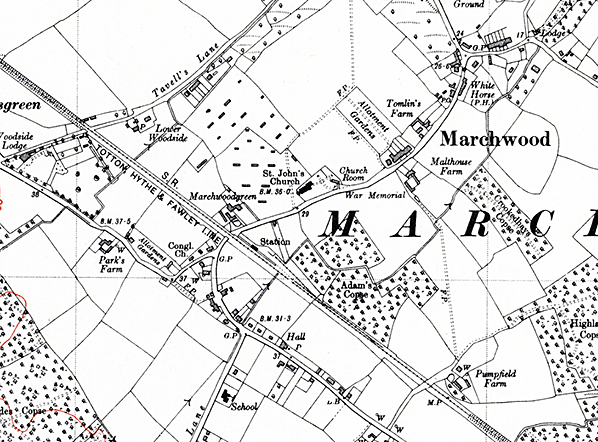
‘There are three stations at Marchwood, Hythe and the terminus at Fawley. They have 350ft x 12ft platforms with walls of the Company's standard reinforced concrete, filling of ashes and finished with gravel or tarmac. The siding accommodation at all stations includes loading docks with moveable cattle pens. Station buildings are of an attractive type combining a general tickets, parcels and goods store, booking hall and waiting room, men's and ladies’ lavatory accommodation, a porters’ room and a coal store and a lamp room. Radiators are supplied from a Sentry boiler in the parcels office. Marchwood and Fawley are lit by oil lamps. Hythe is electrically lit.’
‘The junction between the new Light Railway and the main line is controlled from Eling Crossing signal box. The single line from Marchwood runs for a short distance parallel to and south of the down main line. Access is provided from the single line to the latter by means of a facing crossover and thence to the up main line by an old trailing crossover between the two main lines which has been re-equipped for facing movements from the single line. In addition to this running connection there is a trailing connection with the down main line to siding roads, south of the single line, between which and the sidings there is another connection facing traffic on the single line from Totton to Marchwood. The necessary additional signals on the main line have been erected and also new signals on the single line both for running movements in both directions and for movements to and from sidings. The system of working is by electric tablet the whole line consisting of a single section with the tablet instruments at Eling Crossing and Fawley signal boxes respectively. All stations are equipped with telephone communication and the telephone and tablet instrument wires are carried on a reinforced concrete pole line.
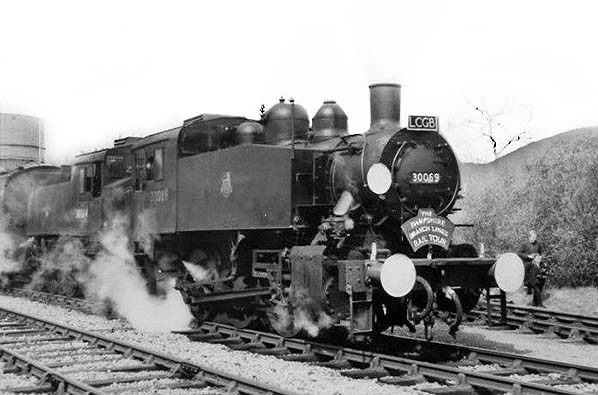 USA class 0-6-0T's Nos. 30069 and 30064 pause at Marchwood with the Locomotive Club of Great Britain 'The Hampshire Branch Lines Rail Tour' of 9 April 1967. The tour commenced from and terminated at Waterloo. In the context of routes covered it was not especially interesting, with all bar the Fawley branch being still open for passenger trains then and now. The two USA tanks operated the Southampton Central - Fawley - Totton leg of the tour. They took over from Battle of Britain No.34057 Biggin Hill and were relieved at Totton by BR Standard 2-6-4T No.80151, the tour then scooting off to visit the Lymington branch. The USA tanks are given brief descriptions elsewhere but it is worth noting here that No.30069 retained the early BR 'Cycling Lion' logo; 1967 being quite late for continued use of this logo. This practice was, however, not uncommon with locomotives assigned to specific tasks; the USA's being normally confined to Southampton docks, carriage preheating and departmental duties. An extreme example was the two Barclay diesel shunters sent to Holyhead breakwater. No.30069 proudly shows off her nicely groomed buffers which appear to have been painted white but were probably silver. Both locomotives saw the end of steam on the Southern Region and were withdrawn in July 1967. No.30064 survived into preservation, the other did not.
USA class 0-6-0T's Nos. 30069 and 30064 pause at Marchwood with the Locomotive Club of Great Britain 'The Hampshire Branch Lines Rail Tour' of 9 April 1967. The tour commenced from and terminated at Waterloo. In the context of routes covered it was not especially interesting, with all bar the Fawley branch being still open for passenger trains then and now. The two USA tanks operated the Southampton Central - Fawley - Totton leg of the tour. They took over from Battle of Britain No.34057 Biggin Hill and were relieved at Totton by BR Standard 2-6-4T No.80151, the tour then scooting off to visit the Lymington branch. The USA tanks are given brief descriptions elsewhere but it is worth noting here that No.30069 retained the early BR 'Cycling Lion' logo; 1967 being quite late for continued use of this logo. This practice was, however, not uncommon with locomotives assigned to specific tasks; the USA's being normally confined to Southampton docks, carriage preheating and departmental duties. An extreme example was the two Barclay diesel shunters sent to Holyhead breakwater. No.30069 proudly shows off her nicely groomed buffers which appear to have been painted white but were probably silver. Both locomotives saw the end of steam on the Southern Region and were withdrawn in July 1967. No.30064 survived into preservation, the other did not.
Photo from the John Mann collection
Athough built under a Light Railway Order, Major Hall considered restricting the axle loading to 16 tons was unnecessary and the company was allowed to use standard branch line engines so long as loading did not exceed safe operating levels for the infrastructure of the line. With no remedial work required, Major Hall authorised the opening of the line to passenger traffic with the first train running on 20 July 1925.
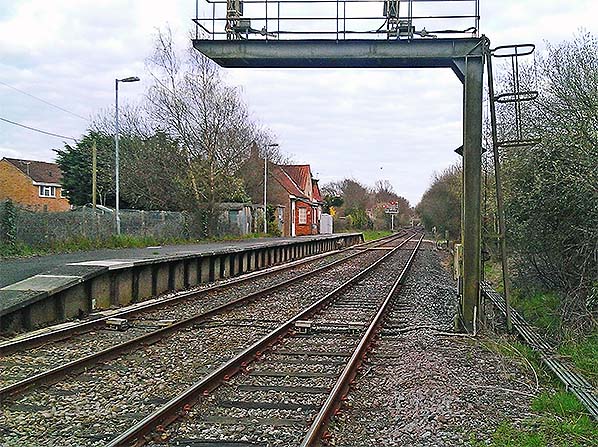 Marchwood staton looking south-east from the level crossing
Marchwood staton looking south-east from the level crossing
The opening of the line was reported in the Southampton Times & Hampshire Express on 25 July: ‘The engine that took the first passenger train along the Totton, Hythe and Fawley Light Railway had a reception at Fawley worthy of the most distinguished person, and the group of people gathered on the platform made a fuss of the whole outfit as though it were some stray pet returned home. The TH&F train had an old look of antiquity about it to those who are accustomed to seeing the great modern expresses of the present day. For one thing, the engine had rather a long smokestack. The carriages consisted of three old SE&CR rolling stock and had a shabby appearance. There were few passengers as it sneaked into Southampton West station at about 7 o'clock in the morning and only about two joined there. On arriving at Totton, however, the train picked up quite a number of passengers who were anxious to take a trip on the new railway, and from then onwards, the train was, so to speak, the ‘big noise’ of the day. Handkerchiefs fluttered from windows, hedges and lanes and although it was still early, those people who were about stopped to cheer the engine and her load.’
‘The train was a ‘big noise’ in more than one sense. Her route through the low-lying meadows naturally necessitate many level crossings, and as most of these are open, the engine, in response to large printed notices, gave a shrill whistle each time she approached a crossing, and between Totton and Marchwood she seemed to be doing nothing else but shriek as though she were overjoyed at making her acquaintance with the delightful countryside. The spire of Marchwood Church came into view through the morning haze and soon the train was drawn up at the first of the new stations. A large number of people were waiting on the trim Marchwood platform, and the train was given a rousing cheer.

'The platform and station buildings, like the bridges, are made of reinforced concrete, and the waiting rooms and offices have delightful red tiled roofs. Concrete seems to have been used everywhere on the new railway and even the telegraph poles and fencing were of this material. The station buildings have not yet aspired to such modern methods of lighting as gas or electricity, and they are illuminated by oil lamps. Indeed electricity would be rather out of keeping with the general tone of this railway.’ (This is incorrect as Hythe was lit by electricity).
‘The route between Hythe and Fawley is almost on the edge of Southampton Water and soon after leaving Hythe station the massive form of the Berengaria in the Floating Dock, could be seen across the water. When the haze had lifted the docks and shipping could be seen on one side, while, on the other, pastureland and delightful parks met the gaze. Where the line borders some of the parks, the owners have insisted that the shrubs should be planted to hide the railway from view as much as possible, because they regard it as an ‘eyesore’. The cattle grazing in the meadows had not yet got accustomed to the new invader, and as she passed by, horses, cows and sheep tossed up their heads and dashed away.
10.jpg) The Lea Valley Railway Club's Royal Wessex railtour of 25 April 1976 approaches Marchwood on its return from Fawley to Waterloo. Class 33 No.33103 is at the head of the 9-car train (2 x 4TC + buffet car) and No.33115 is on the rear. The train departed Fawley right time at 19:59 and passed Marchwood as it was getting dark. The train reached Waterloo four minutes early at 21:49. The station building can be seen directly ahead. The train appears to be on a curve; in fact it is negotiating the dogleg and has just passed the junction with the military railway, to which the signal on the shorter dolly applies.
The Lea Valley Railway Club's Royal Wessex railtour of 25 April 1976 approaches Marchwood on its return from Fawley to Waterloo. Class 33 No.33103 is at the head of the 9-car train (2 x 4TC + buffet car) and No.33115 is on the rear. The train departed Fawley right time at 19:59 and passed Marchwood as it was getting dark. The train reached Waterloo four minutes early at 21:49. The station building can be seen directly ahead. The train appears to be on a curve; in fact it is negotiating the dogleg and has just passed the junction with the military railway, to which the signal on the shorter dolly applies.
Photo
by David Burrows from his Flickr photostream
'The train received the warmest welcome at the terminus, Fawley, where even the sun came out to greet her. Her delighted passengers could not leave her after they had alighted, and they joined all the other people on the platform who had been waiting her arrival, voicing their approval. “There's some milk cans up there”, said the station master proudly, as he indicated the van to the porter. Amateur photographers were soon very busy, and before she left on her return journey, the train, driver and stoker, porters, guards and passengers all posed for their photographs. Several cans of milk had, after some struggling, been placed in the train, but at the special request of one of the photographers they were dragged out again to take their place in the group. There was much competition among the passengers to obtain the first return ticket from Fawley, and eventually, to the accompaniment of cheers and waving of hands, the train started off on her first return journey.’
Even though Fawley and Hythe were close to the seaplane bases on Southampton Water, passenger traffic was never heavy. However, the first timetable did little to attract passengers with no train scheduled to arrive at Fawley between 7.46 am and 4.34 pm. Branch trains commenced from either Southampton Terminus or Central stations and there was little change in the service until the 1950s.
With little chance of increasing passenger revenue the railway's salvation was the dramatic build-up of oil traffic from the refinery at Fawley. In 1925 the refinery was acquired by John D Rockefeller’s Standard Oil Company of New Jersey.
Prior to the arrival of the railway, No.1 Asphalt Plant and No.1 Boiler House were in operation. This was a manufacturing and filling plant for making timber barrels. Although the line carried both paraffin and petrol from opening the main products conveyed were asphalt and bitumen which were transported in wooden barrels in open wagons. As the refinery continued to be expanded and modernised rail traffic steadily increased.
After the Admiralty Magazine was set up at Marchwood, the Navy ran a thrice-daily steamboat from Southampton Royal Pier to Cracknore Hard for the workers there; this seems to have continued after the opening of the Fawley branch as it is recorded that the vessel Laurel was replaced on the service in 1926 by the Crocus.
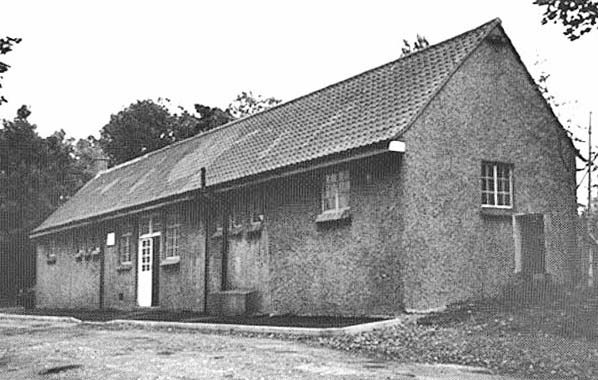 Hythe station building in the 1970s
Hythe station building in the 1970s
Photo from the John Mann collection
Refining of crude oil at Fawley ceased during World War II because of the threat of a German air attack. The facility was, however, used for bulk storage with new underground fuel tanks being built to the west of the station for the Air Ministry in 1942. New sidings were laid to serve this new depot. Fawley did have a strategic role to play supplying fuel for the Allied forces involved in the D-Day landing in Normandy in June 1944. Tens of thousands of cans of petrol arrived at the refinery by rail during the build-up to the invasion with the overhead ropeway from the bitumen plant to the jetty being used to transport the cans to landing ships.
The importance of the Southampton area in World War II needs no stressing. Of course, it made the southern end of the branch a strategic area, in view of the refinery. However, it was also made important in the Marchwood area by the construction in 1939 of a long siding from south of the station to Cracknore Hard at the north end of Southampton Water, which became the centre of various marine fighting and landing projects. Ultimately there were 30 miles of track in the Marchwood Military Railway complex, with passenger trains made up from old main line bogie stock, and four ‘stations’, at Mulberry Platform, Park Gate, Model Room and Jetty. Cracknore Hard to Marchwood Junction measured 1½ miles. The heaviest locomotives could be used, but in fact most traffic was hauled by O-6-OTs. During the 1950s reservists were carried by through trains from Waterloo to Marchwood Military Siding.
The refinery survived the war with little damage and in 1945 the production of petrol, middle distillates and residual fuel oils resumed using imported crude oil; by 1946 the plant was working at full capacity of 600,000 tons of crude a year.
In July 1949 work started on the construction of a new refinery following the British Government's strategy of making the country more self-sufficient in the refining of crude oil. A new deep water jetty was built on 3,000 acres of mainly marshland purchased from the Cadland Estate. The new refinery itself was on the west side of the railway on 1,000 acres of Cadland Park (originally laid out by Capability Brown) which was acquired from the Estate under the threat of compulsory purchase. This also required the demolition of the old Cadland House.
A new network of railway sidings was also required on the west side of the line, and once the new access line came into use on 7 January 1950 construction materials started arriving by rail. During the construction of the new jetty and refinery the railway had a vital role in transporting huge numbers of contraction workers to the site every day. By 1 March 1950, 2,000 workers had been employed and this was expected to increase, peaking at 4,500.
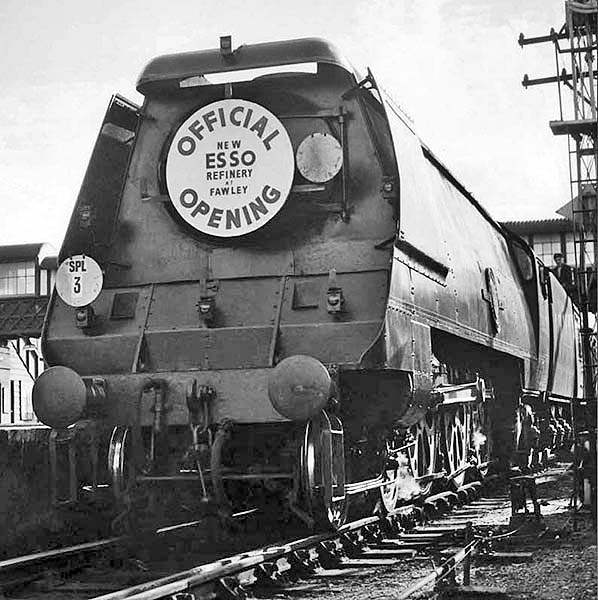 One of two special trains from London has arrived at Brockenhurst on 14 September for the opening of the new Fawlwy oil refinery.
One of two special trains from London has arrived at Brockenhurst on 14 September for the opening of the new Fawlwy oil refinery.
The first part of the new refinery came on line on July 1951 with the facility being officially opened by the Prime Minister, Clement Attlee, on 14 September. Two special trains ran from London: one ran to Brockenhurst from where guests were transported to Fawley by road while the other ran to Fawley station. A third special ran from Southampton to Fawley. All three trains carried special head boards. Within two years, refining capacity had increased to 6 million tons a year. The Esso brand name first appeared in the UK in 1934 but it was not until 1951 that the Anglo-American Oil Company changed its name to the Esso Petroleum Co. Ltd.
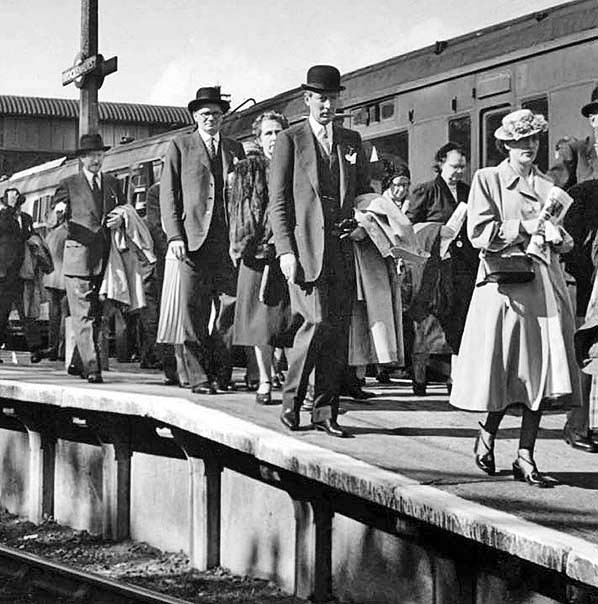 Some invited guests alighted at Brockenhurst on 14 September 1951 and were transported to Fawley by road for the opening ceremony of the new Fawlwy oil refinery.
Some invited guests alighted at Brockenhurst on 14 September 1951 and were transported to Fawley by road for the opening ceremony of the new Fawlwy oil refinery.
As the new refinery and jetty was a mile to the north of Fawley station a new workers' station called Hardley Halt opened on 5 April 1954.
As only tank locomotives were permitted because of absence of turning facilities and the ungated level crossings, loaded wagons soon proved to be beyond the resources of one, or even two, small engines. Robert Urie's hefty Pacific tanks, the 'H16' class built in 1921, were tried out early in 1960 and soon became a familiar sight on the oil trains, but even they needed assistance up from Fawley. A loop was put in at Marchwood to allow trains to pass on the 9-mile branch. With the withdrawal of the `H 16' tanks during 1962, they were replaced by the freight-only Class W 2-6-4T locomotives dispatched from London; again, double-heading proved necessary with loaded trains. In 1964, diesel locomotives took over and were allowed to travel through to Fawley.
Hampshire DEMUs, built at Eastleigh, began trials in the area in August 1957. The first two-car Hampshire unit ran on the Fawley branch on Sunday 12 October 1958 with one train in each direction. From 16 November 1958, DEMUs were in regular use on the branch, but only on Sundays with 3-car units taking over in 1959. By the summer of 1962 most weekday services were diesel operated. The only steam-operated services were now the 6.22am (SO) Eastleigh - Fawley, the 12.41pm (SO) Fawley - Southampton and the 6.43 pm (SX) Fawley - Eastleigh. By this time there were only three trains in each direction per day, conveniently timed for the refinery workers but with gaps of up to five hours between trains during the day. By the winter timetable of 1962/63 the service was further reduced with the withdrawal of all weekend trains leaving only two trains in each direction during the week; these were the 6.28am Eastleigh - Fawley, the 8am Fawley - Southampton, 3.46pm Eastleigh - Fawley and the 4.50 pm Fawley - Portsmouth Harbour. The introduction of Hampshire DEMUs was to be short-lived as closure to passenger traffic was looming.
Surprisingly, the Fawley branch was not recommended for closure in Richard Beeching's The Reshaping of British Railways. A summary of all passenger railway services recently undergoing closure procedures in Hansard of 28 February 1966 identifies Southampton – Fawley as 'Added since publication of the Beeching Report'; this description also applied to nearby Boscombe, Bournemouth West, Northam and Southampton Terminus stations. Notice of the Fawley Branch closure was officially published on 11 June 1965 and the hearing closed on 7 September 1965. The Transport Users’ Consultative Committee (TUCC) report was received by the Minister of Transport (Thomas Fraser) on 9 November 1965 and he consented to closure on his last day of office, 22 December 1965 - Barbara Castle succeeded him. Closure came on 14 February 1966: an unusually swift process. At this time the three stations remained open for goods traffic but final closure to all traffic came on 2 January 1967.
old16.jpg) Through the 1960s, huge quantities of naphtha (a petroleum distillate) were supplied to the gas industry for the production of town gas. Fawley had contracts with many gas boards and substantial quantities of naphtha and, from 1973, liquid petroleum gas (LPG), were shipped from Fawley by rail. A new rail LPG rail terminal was built on the east side of the line opposite Cadland Sidings.
Through the 1960s, huge quantities of naphtha (a petroleum distillate) were supplied to the gas industry for the production of town gas. Fawley had contracts with many gas boards and substantial quantities of naphtha and, from 1973, liquid petroleum gas (LPG), were shipped from Fawley by rail. A new rail LPG rail terminal was built on the east side of the line opposite Cadland Sidings.
In 1971 the CEGB opened a power station at Fawley. It was oil-fired, powered by heavy fuel oil. A pipeline connected the station to the nearby Fawley oil refinery. Because oil is more expensive than other fuels such as coal and natural gas, Fawley did not operate continuously, but came on line at times of high demand.
0-6-0T No.30062 stands at Fawley with an RCTS special on 17 May 1953.
Photo from Mike Morant collection
In 1973, the capacity of Fawley refinery was 19½ million tons of crude oil a year of which 8% was transported by rail. In October 1973 members of the Organization of Arab Petroleum Exporting Countries (OPEC) proclaimed an oil embargo. By the end of the embargo in March 1974, the price of crude oil had quadrupled from US$3 per barrel to nearly $12 globally. As a result of this huge increase the demand for all oil products dropped.
Large quantities of Natural Gas were discovered beneath the North Sea in 1965 with the first oil field being discovered in 1969. Following the 1973 oil crisis North Sea oil exploration began in earnest in an attempt to reduce Britain’s dependency on Arabian crude oil. The Piper oilfield was discovered in 1973 and the Statfjord and Ninian fields in 1974. Offshore production in the North Sea became more economically viable after the 1973 oil crisis. In the mid 1970s naphtha traffic from Fawley ceased when town gas was phased out and replaced by natural gas from the North Sea.
Another blow to rail traffic came in the 1980s with the construction of a new pipeline from Walton to supply aviation fuel to Gatwick Airport. This put an end to all rail traffic between Fawley and the Salfords terminal. Shortly afterwards, Esso decided to stop using rail to transport for any white spirit (petrol, naphtha, etc), from Fawley owing to the high cost of renovating the tank loading racks at Fawley to meet modern safety requirements.
.gif) There was however soon to be an upturn in the fortunes of the Fawley branch following the discovery of onshore oil in Dorset in the late 1970s. Initially, crude oil from British Petroleum (BP) Wytch Farm wells was loaded onto tankers at Furzebrook, near Corfe Castle from where it was transported to BP’s Llandarcy refinery in South Wales. From 1 January 1986 these trains were diverted to Fawley with two trains a day on Monday to Friday. This new business was further supplemented by three trains a week from Holybourne (near Alton) in Hampshire following the development of the Humbly Grove Carless oil field after its discovery in May 1980. By the end of 1987 there was a larger tonnage of crude oil arriving at Fawley by rail than oil products leaving the refinery.
There was however soon to be an upturn in the fortunes of the Fawley branch following the discovery of onshore oil in Dorset in the late 1970s. Initially, crude oil from British Petroleum (BP) Wytch Farm wells was loaded onto tankers at Furzebrook, near Corfe Castle from where it was transported to BP’s Llandarcy refinery in South Wales. From 1 January 1986 these trains were diverted to Fawley with two trains a day on Monday to Friday. This new business was further supplemented by three trains a week from Holybourne (near Alton) in Hampshire following the development of the Humbly Grove Carless oil field after its discovery in May 1980. By the end of 1987 there was a larger tonnage of crude oil arriving at Fawley by rail than oil products leaving the refinery.
In November 1987 it was announced by the CEGB that Fawley had been selected as the site of a new coal-burning power station alongside the oil-fired ‘A’ power station. The CEGB's plans envisaged importing some coal for transport by rail to inland power stations with rail traffic expected to be 2 million tonnes a year or seven loaded trains a day, five days a week. This new traffic would have required an upgrade of the track and signalling with a 750-metre extension of the track from the existing terminus to the new power station. The plans were quickly dropped following privatisation of the electricity industry in 1990.
With freight traffic on the Fawley branch very light at weekends Fawley was the destination for many enthusiasts’ railtours which included:
R.C.T.S. (South of England Branch): Southampton Docks & Fawley Branch Rail Tour, 17 May 1953
Southern Counties Touring Society The Hampshire Venturer 10 March 1963
LCGB The New Forester Rail Tour 19 March 1966
R.C.T.S. The Solent Rail Tour, 20 March 1966
L.C.G.B. The Hampshire Branch Lines Rail Tour, 9 April 1967
Lea Valley Railway Club Royal Wessex 25 April 1976
British Young Travellers Society The Fawley Flyer, 23 April 1978
RCTS/ SEG The Marchwood Volunteer 22 July 1978
RCTS/ SEG Marchwood Volunteer No.2 Rail Tour 21 July 1979 (visited Marchwood Military Railway but not Fawley)
SEG The Hastings Diesel Wanderer 11 September 1982
Branch Line Society The Intrinsic Treacle Eater 29 November 1986
Class 33 Preservation Group Push-Pull Farewell Railtour 7 May 1988
Pathfinder Tours The Wessex Adventurer 5 November 1988
Hertfordshire Rail Tours The Crewe Avoider 20 April 1992
Branch Line Society The Hampshire & Sussex Explorer 19 June 1993 (Visited Marchwood Military Railway and Fawley)
Pathfinder Tours The Logistician 24 June 1995 (Visited Marchwood Military Railway but not Fawley)
Hastings Diesels Ltd The Wessex Wanderer 15 September 2001
Hertfordshire Rail Tours The Dorset Ooser 20 October 2001
UK Railtours: The Solent Witness, 28 December 2012
UK Railtours: The Swaythling Bands, 8 December 2015

On 16 June 2009 the Association of Train Operating Companies announced it was looking into the reopening of the railway (now known as the Waterside Line) to passengers as far as Hythe, with a possibility of a further extension to Fawley if agreement could be reached with Esso, which now owns the land where Fawley railway station is located.The proposals included reopening of all former stations along the line with a new station in Totton called Totton West, sited just west of the junction with the main line. A new train service was proposed from Fawley or Hythe to Totton and onward via Southampton Central, Southampton Airport Parkway, Eastleigh, Chandlers Ford and Romsey before returning to Southampton Central, Totton and Fawley or Hythe, also serving other intermediate stations.
It was envisaged that the railway could be built over a 5 to 10-year period at a cost of around £3 million. The service would be operated by current franchisee South West Trains using diesel multiple units. If the scheme delivered a sufficient financial return, there would be a possibility of eventual electrification. The service was planned to run half hourly during peak times and hourly at other times.
32.jpg)
A pleasant view of some of Fawley Refinery's storage tanks on 23 April 1978 seen from across the railway station. At the platform is the British Young Travellers Society shuttle train formed of DEMUs 1131, left, and 1128, right. Despite the Society name, the travellers clearly included people of all age groups but presumably the shuttles were not restricted to Society members and others took the opportunity for a trip on the line. It is believed the 6-car train made three round trips,
Photo
by Ian Nolan from his Flickr photostream
On 8 November 2013 Councillor David Harrison of Totton South and Marchwood obtained a copy of the final GRIP 3 Study report. In the report it was stated that the service would be half hourly, using Diesel Multiple Units calling at all stations between Hythe and Southampton, including a new station to be called Hounsdown (originally planned to be called Totton West). A new passing loop would have to be installed at Hounsdown to allow passing of freight and passenger trains. Other upgrades would include AWS/TPWS and signalling. Owing to security reasons at the oil refinery, Fawley station would not be reopened as part of the scheme. It has been pointed out that there are some possible drawbacks to this scheme. For example, if the Waterside Line gets the green light, the subsidy from Hampshire County Council for the Southampton & Hythe Ferry service would be likely to cease, also the local bus companies who operate in the area might be at risk of losing some of their subsidy.
On 21 January 2014 Hampshire County Council decided to shelve the plans to reopen the line. The council's report came down against committing further funding for the scheme owing to a perceived poor value for money business case, although it said that the authority should review the position should local circumstances change.
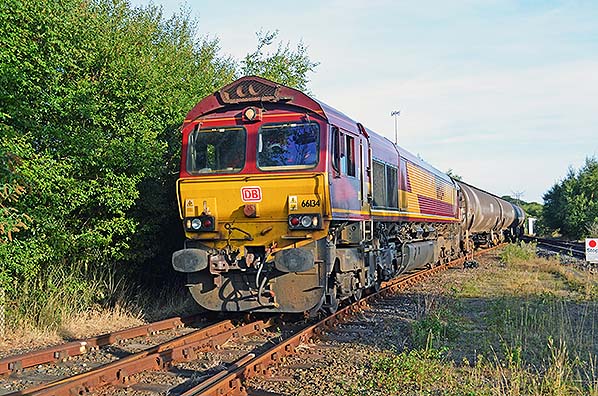 The final booked working to Fawley Refinery arrives at its destination on 1 September 2016. The locomotive is General Motors Class 66 No.66134, from the batch of 250 originally purchased by EWS, a subsiduary of Wisconsin Central Railroad. No.66134 still carries EWS livery but with the branding of its successor DB Schenker which itself is a subsiduary of Deutsche Bahn AG, the now-ostensibly-private German railway system which has the Federal Republic of Germany as its sole shareholder.
The final booked working to Fawley Refinery arrives at its destination on 1 September 2016. The locomotive is General Motors Class 66 No.66134, from the batch of 250 originally purchased by EWS, a subsiduary of Wisconsin Central Railroad. No.66134 still carries EWS livery but with the branding of its successor DB Schenker which itself is a subsiduary of Deutsche Bahn AG, the now-ostensibly-private German railway system which has the Federal Republic of Germany as its sole shareholder.
On 1 September 2016 the final delivery of crude oil by rail arrived at Fawley following the refinery’s decision to receive all crude oil by sea. Campaigners for reopening the branch to passenger traffic fear the track will be ripped up, consigning part of the county's transport heritage to the history books and ending hopes of giving villagers a rail route to Southampton for the first time in half a century. Network Rail has stated that the track between Marchwood and Fawley is to be mothballed and there are no plans to lift it at this time. The line will simply remain in situ and gradually become overgrown. Following 20 years of disuse but with at least some track in situ, such lines are then legally considered closed avoiding the expense of formal closure procedures.
3.jpg) The remains of Fawley station, with a rake of tanks present, on 1 September 2016. Note the truncated platform end.
The remains of Fawley station, with a rake of tanks present, on 1 September 2016. Note the truncated platform end.
Despite the well publicised 'last train' on 1 September the previously scheduled 09:21 Fawley Esso - Eastleigh departed on time on 13 September; however the down working, 07:39 ex-Eastleigh, was cancelled and a light locomotive sent to Fawley instead. This working would have probably been to collect wagons still standing at Fawley.
Click here to see the Waterside Rail Study, commissioned by Hampshire County Council and published in June 2013. (91 page PDF file)
Route map drawn by Alan Young
Films:
Sources:

